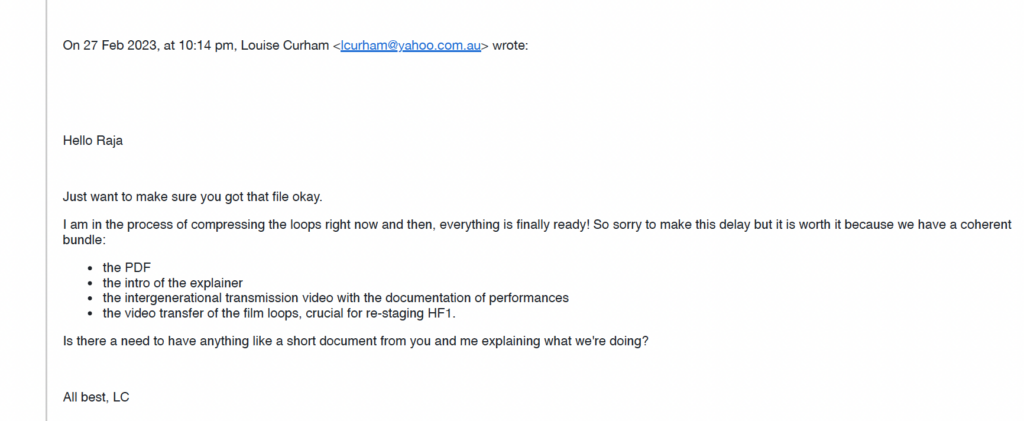We recently received an email requesting advice on how to make a users manual for the re-enactment of a historical artwork.
here are a few notes:
We have a few academic papers:
this is from before we made the user manual for horror film 1:
Performance Matters Journal: Re-enactment of Malcolm Le Grice’s “Horror Film 1”
This is more recent and explicitly discusses the HF1 user manual (briefly)
Re-enactment, Users Manuals and DNA Storage: methods for media art preservation
recent blog post about the HF1 manual
you can also see our 2009 user manual for (wo)Man With Mirror
louise’s phd thesis (see chapter 4 on user manuals)
https://researchoutput.csu.edu.au/en/publications/tending-the-archive-how-re-use-of-ephemeral-artworks-contributes-
some key ideas:
- building trust through socialising with the artist
- oral history interviews
- explicit learning about choreography and technical things
- research on / with the artist in archives if available
- trying out the re-enactment for ourselves
- checking back with the artist to fill in gaps
- writing a manual FOR OURSELVES so we remember what we did (make it easier next time)
- writing a manual with the view to pass it on to someone else (technical stuff, contextual stuff, and stuff about the ‘spirit of the work’
- trying the draft manual out with someone else
- noting what needs changing based on that
- make the changes that need to be made
- when another person tries it out, documenting their attempt and including it in the next iteration of the user manual
etc (ad infinitum, never finished…)
Louise adds:
I used the insights Lucas and I have gained to work with an Australian artist to do something just like you’re planning – to make a manual herself. I wrote a blog post about that:
https://nga.gov.au/stories-ideas/manual-making-for-ephemeral-art/
I think the keys are:
- you need to observe yourself making the work and keep notes about that. That’s what becomes the manual.
- You need to try to be ‘true’ to the work, that’s your job.
- You need to find your way to capture your observations that make sense to you as a record of that experience.
- As Lucas says ‘writing a manual FOR OURSELVES so we remember what we did (make it easier next time)’.
- For me, the letter (or some communication) to a future user from the original artist is crucial, a key finding in my PhD is that without that permission, people feel awkward to just go ahead and use the manual.
- We’re still working on a way to really make it do the ‘ad infinitum’ bit, ie to get users to make a contribution back to the manual, that’s what really strengthens it.

 I did try to update that title of that last file – that is an example of what not to do in digital preservation!
I did try to update that title of that last file – that is an example of what not to do in digital preservation!






